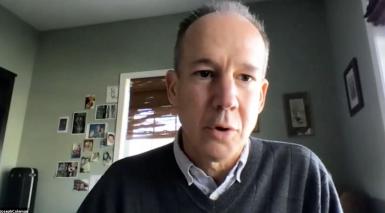Journalism, migration workshop fosters IU, UNAM student collaboration

About 35 student journalists, practicing professionals and professors tried Friday to answer a timeless question only growing in media coverage: What does it mean to be a migrant?
Media School professor of practice Joseph Coleman worked with IU’s Global Gateway program and The National Autonomous University of Mexico to create a collaborative conference titled “Reporting the Border: A U.S.-Mexico Approach to Journalism of Immigration.” The conference included three panels on Thursday — Immigration in North America, Journalism and Immigration, and Migration Today: Challenges and Trends During the Pandemic — and concluded with a Friday workshop between members of Coleman’s Immigration Reporting class and students from UNAM.
Students began by sharing their current projects and thoughts on immigration reporting from their respective countries. Some students spoke in English, and some spoke in Spanish. Coleman and UNAM’s Daniela Lemus translated. A speaker at the workshop, journalist Eileen Traux, decided to use Spanglish for her presentation, she said, laughing before rotating between languages.

Traux urged students to become migration journalists, not immigration journalists. Media framing shapes the way audiences think about migration, she said.
“Preservamos la narrativa ‘ellos’ y ‘nosotros,’ Traux said, noting that the way contemporary journalists construct stories can perpetuate a binary “us” versus “them” mode of thinking.
She showed examples of headlines calling migration a crisis and a problem, and dominant photos showcasing poverty and stereotypes of migrants.
“We in the media only portray migrants when they are in transit,” she said.
Considering responsible language use and telling all kinds of stories about the people in our communities is paramount to changing the perception of migration in journalism, she said.

“Words, images and even sounds are so powerful to change their mind about any topic,” Lía Juy, who studies international relations at UNAM, said. Juy’s reflection was in response to a question Traux asked the group: ¿La xenophobia lo mismo que el odio? Is xenophobia the same as hate?
The question drew mixed responses from participants. Xenophobia is based in fear, ignorance and prejudice, a slide from Traux’s presentation read.
Participants shared their belief that access to accurate information could fight the growth of xenophobia and subsequent hatred.
Immigration, Traux said, is not the problem. Violence, poverty and unsafe conditions are the problem. Immigration is the consequence, she said.
Migration is a global phenomenon, and one of the three major topics of the 21st century, alongside climate change and women’s rights, Traux said.

“Leer, leer, leer,” Traux said. Read, read, read. She concluded asking students to read about global issues to more effectively report them.
“It’s going to be your job to fix this mess we are leaving behind in media organizations,” Coleman said, lightly laughing.
Coleman wanted to organize the conference to give students an opportunity to share their experiences in different parts of North America.
“This is a topic that unifies our countries and we share in an intimate sense,” Coleman said in an interview. “Immigration is often an issue that divides people, and it’s nice to be a focal point to bring people together, to foster collaboration.”

